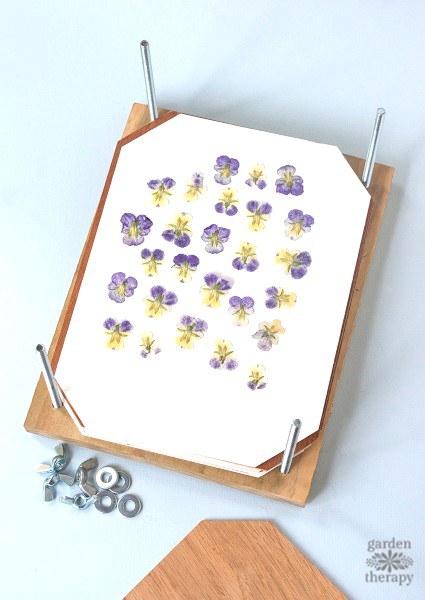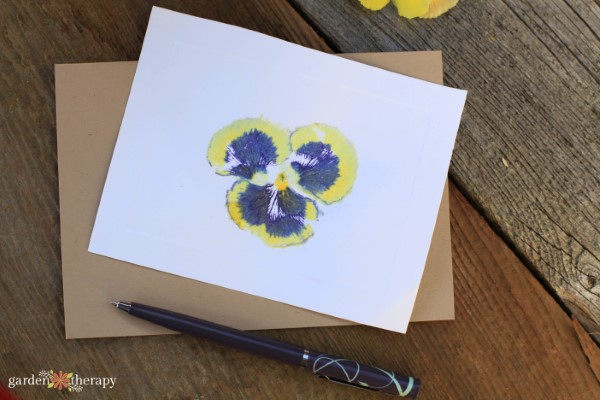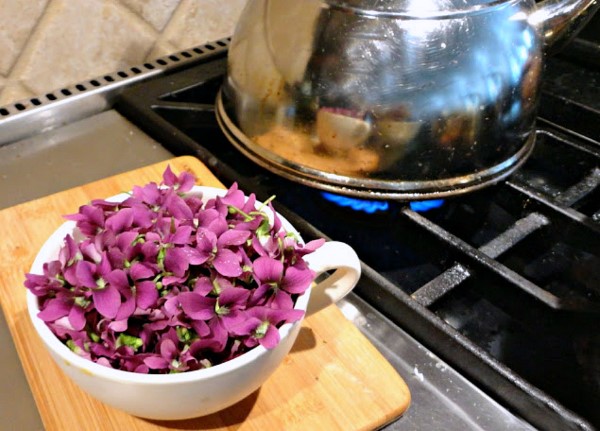One of the most recognized garden flowers, just about every gardener has come across a viola, pansy, or violet. Frost-tolerant beauties, they’re one of the first flowers to enjoy in the early season. And with such a low price point, you can easily use them to fill your garden with tons of colour. Learn about the key differences between the flowers and the many ways you can use them.
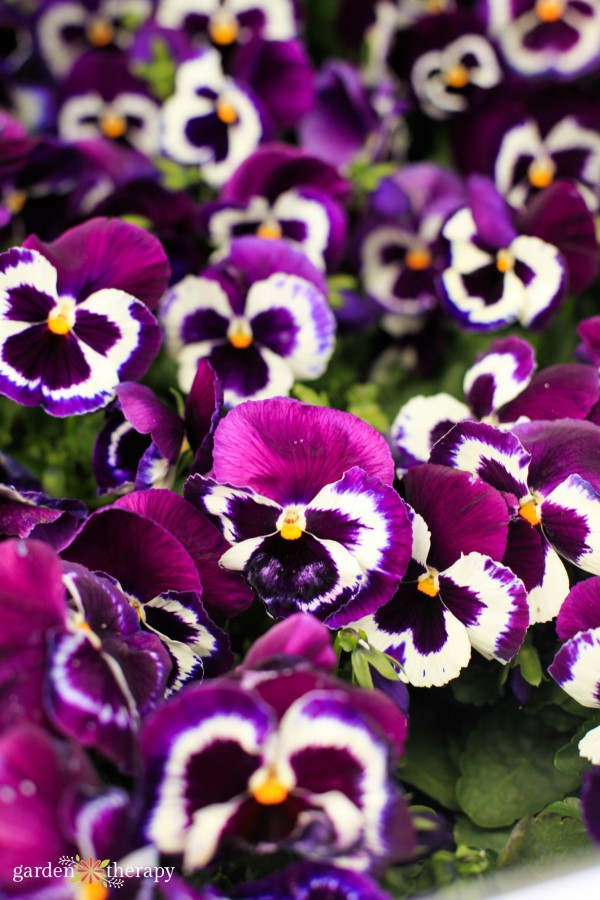
In my garden, I grow very few annuals. Yet, I’m always drawn to the classic pansy and viola as they’re one of the most versatile and easy to grow annuals out there. Not only are they great for filling in the garden, but they’re an edible delight too.
The next time you’re at the garden centre, don’t walk by the trays of pansies and violas that are $5 or less for six or ten plants. Grab a tray or two! Enjoy their little smiling faces and use them to easily bring colour to your garden when frost still looms.
This post will cover…
- Demystifying Violas, Pansies, and Violets
- Viola sororia
- Viola tricolor
- Viola odorata
- Viola x wittrockiana
- Uses for Viola Flowers
- Garden Flowers
- Medicinal Herb
- Edible Flower
- Planting Pansies
- Growing Pansies from Seed
- Caring for Pansy Flowers
- How to Harvest Pansies
- Viola Recipes
- Wild Violet Flower Simple Syrup
- Edible Flower Lollipops
- Edible Flower Ice Cubes
- Flowerfetti Salad
- Frequently Asked Questions About Violas, Pansies, and Violets
- More Flowers to Plant
Demystifying Violas, Pansies, and Violets
In the violet family Violaceae, there are around 1,000 species. Viola is the botanical name for violets, violas, and pansies, and people often mix up all three terms. While they all belong to the same family, they’re in fact different flowers.
When referring to pansies, people are often talking about the bigger blooms. Violas in the garden typically have smaller blooms but have more of them. They both have similar growing conditions and care in the garden. While technically short-lived perennials, many gardeners treat them as annuals.
Here are some of the most common plants you will find in the violet family.
Viola sororia
Also known as the common blue violet, these are the ones you see dotting lawns and fields. Many curse them as weeds since they’re self-seeding and spread easily. But I think they’re a beautiful and edible flower.
They appear very different than the others listed below, with heart-shaped leaves and 5 petals of either blue, purple, white, or yellow. The bottom three petals are veined and the lowest curl back. These pretty blooms are native to North America.
Viola tricolor
These guys are also referred to as wild pansies or Johnny Jump Up. When you see plants labeled or talked about as violas, this is what they’re referring to. They’re smaller and have lots of bloom at a time per plant.
They come in purple, blue, yellow, or white. The most common colouring of their five petals consists of two purple flowers on top, white petals underneath, and a lower yellow petal.
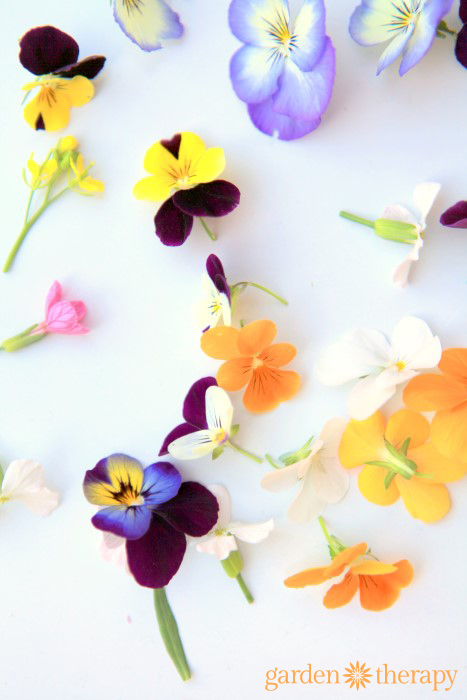
Viola odorata
Known as the sweet violet or English violet, this is the violet flower with the most scent. With a sweet floral fragrance, it has inspired many perfumes. You can find them in dark to light purple, white, or pink colours.
Native to Europe and Asia, you can also find them in North America and Australia.
Viola x wittrockiana
The one you probably know the best, this variety is referred to as the garden pansy and is easily found in garden centres, grocery stores, and hardware stores. A hybridized viola, it’s cultivated from the Viola tricolor.
The large flowers have incredible colour versatility, coming in just about every shade and colour combination imaginable.
Uses for Viola Flowers
Not only are these blooms beautiful, but they are useful too. Here are a few ways you can utilize violas.
Garden Flowers
Every cool season gardener has included pansies in their beds. A highly versatile flower, they will give you a burst of colour when few other flowers can. They’re often intermixed among spring bulbs.
They work wonderfully as garden borders, in containers, hanging baskets, and amongst your vegetable garden as an edible flower.
When given boosts of fertilizer, they can get quite bushy and can fill in bare patches throughout the garden for cheap.
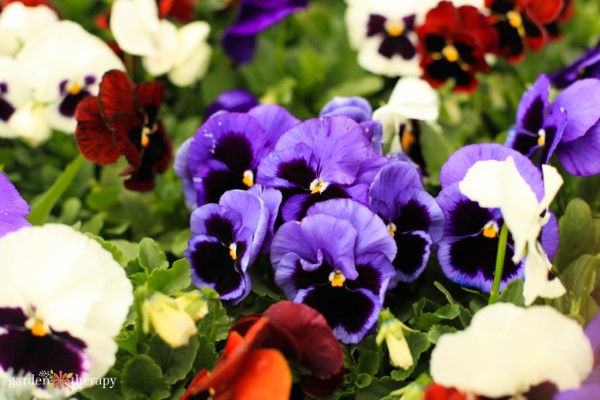
Medicinal Herb
Several violets are used for medicinal purposes: Viola odorata, Viola tricolor, and the native American violets Viola sororia and Viola pedate. In Traditional Chinese Medicine, they use the Viola yedoensis.
Violets have a good dose of Vitamin C in them are known for promoting restful sleep and easing headaches. Ancient Greeks also used the herb to moderate anger and strengthen the heart.
One of the most beneficial uses of the herb is for helping coughs and respiratory conditions. The moistening nature of violets especially helps dry and inflamed respiratory systems.
Know for heat-clearing, violets reduce fever and inflammation. It can be applied topically to help with inflammation of the skin and other skin conditions like eczema and psoriasis.
Violet flowers are even known to have anti-cancer and chemosensitizing effects which have shown promise in treating drug-resistant breast cancer.
Edible Flower
One of the most popular edible flowers, people from professional cake decorators to home gardeners use violas to adorn their food. They work well as garnishes for desserts, drinks, salads, and pizzas.
When it comes to violas, you can experience a variety of tastes, some being strong with grassy, green flavours and others mild with a sweet, pea-like flavour.
If you want to eat them, I recommend growing them from seed. They’re not a difficult seedling to grow and you can get them started very early in the season.
Not all violas are edible. Make sure you properly identify all flowers before eating them. You can eat any of the violas listed above.
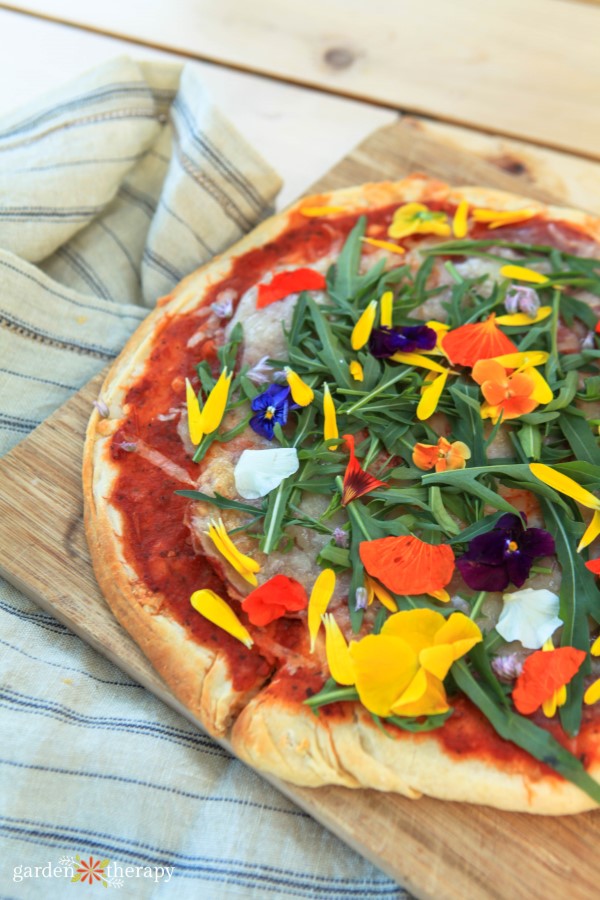
Planting Pansies
You’ve got some options when it comes to the pansy! You can plant them in either spring or fall depending on when you want blooms. For spring and early summer blooms, plant the pansies in late winter as soon as the ground is workable six inches apart. Cool lovers, they can withstand a frost so don’t be scared to plant them early.
Pansies die back in the hot heat, so they may not make it through hot and dry summers. However, you can get blooms all summer long with the right temperatures. They work well in zones 3-8.
For fall flowers, plant in early autumn. This gives them time to establish and they may even survive a mild winter. Plant these pansies closer together as they won’t get as bushy in the fall.
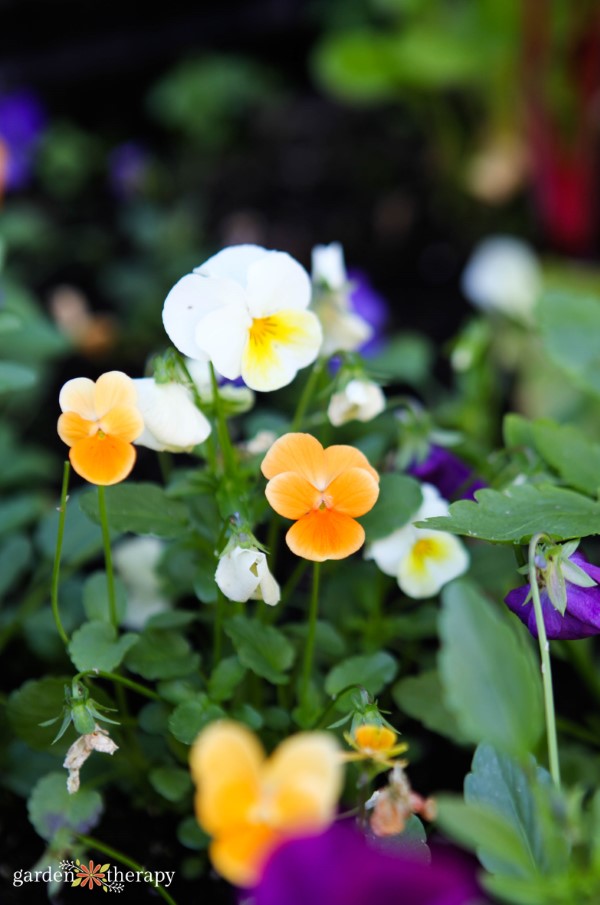
Growing Pansies from Seed
If starting pansies from seed, you will want to start them early. For spring blooms, start the seeds in late winter from February to March. For autumn, sow the seeds from May to June to get those early fall flowers.
While you can directly sow them, your chances of success will be better starting them indoors. Start with high-quality potting soil in a tray. Surface sow the seeds and then place the tray in a black garbage bag so no light can pass through.
Place the bag in a cool spot and check for growth once a day. Meanwhile, keep the soil moist while waiting for the seeds to germinate.
Once they’ve germinated, move to a spot with bright and indirect light. As soon as the soil is workable, the seedlings can be transplanted. Give them a couple of days outside before planting to accustom them to the outdoors.
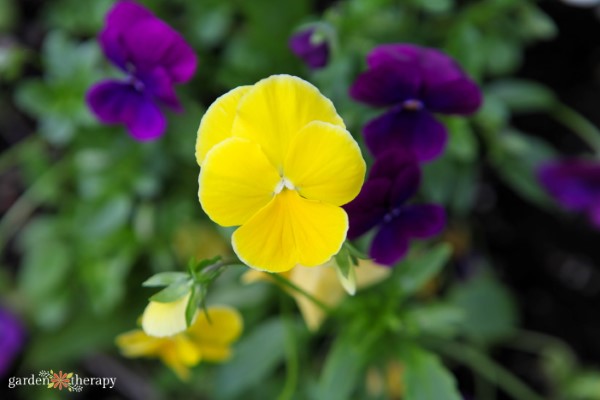
Caring for Pansy Flowers
Like most plants, pansies do well in well-draining and fertile soil. However, they’re fairly hardy and will withstand most soil conditions.
They like partial sun best, needing approximately 6 hours of full sun for the best flowers. In hot climates, make sure to protect them from the hot afternoon sun.
Pansies need regular watering, especially during dry spells. Aim to water the soil rather than the leaves and flowers. If you notice them getting droopy, give them a good dose of water and they should perk back up.
To get lots of bloom, give them a liquid-based fertilizer every other week. Remove old blooms by pinching them off with your fingers to encourage more flowers to form.
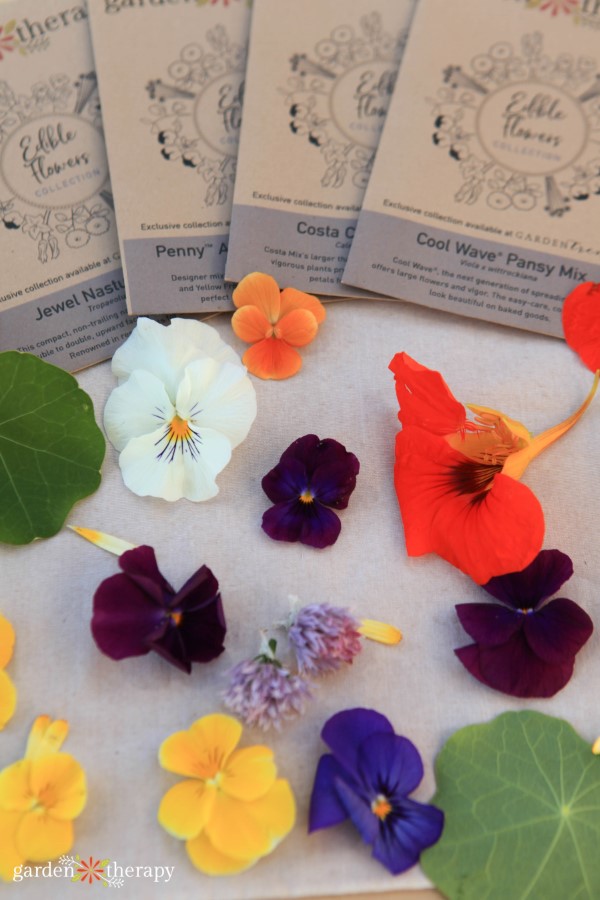
How to Harvest Pansies
If you want to harvest pansies (or others in the violet family) as edible treats, you want to pick them in the morning when the water retention is the highest. Slightly droopy pansies will perk right up when soaked in ice water for a few seconds. Use the pansies the day you harvest them and place them in the fridge until you’re ready to use them.
Make sure to only ingest organic pansies. Ones you have grown from seed are good to go as soon as they emerge. However, if you get them from the garden centre, you will want to immediately pop off all the current flowers and wait for new flowers to grow. Those are the ones you can eat.
While the garden centre or the grower may not spray them with pesticides, the trucks that transport them spray the whole cargo.
Viola Recipes
Let’s dive into the ways you can consume this delicate bloom. Here are my 4 favourite viola recipes!
Wild Violet Flower Simple Syrup
I love making homemade soda. It has no preservatives or chemicals and feels guilt-free in comparison to the popular brands from the store. You make a soda flavoured and coloured with wild violet flowers with this simple syrup recipe. Perfect for warm-weather sipping, you can even add a splash of vodka or gin.

Edible Flower Lollipops
Making your own lollipops is surprisingly easy. For special occasions, I’ve made clear lollipops and put an edible flower inside. Absolutely gorgeous and delicious, I always find violas are the star of the show for me.

Edible Flower Ice Cubes
Perhaps my favourite party trick, edible flower ice cubes make any drink beautiful. I use them in the summer for all kinds of sodas and cocktails. They look great in special drinks for occasions like birthdays and weddings, or even just a fun weekend treat. Violas perfectly fit inside an ice cube tray and have one of the nicest flavours in terms of edible flowers.
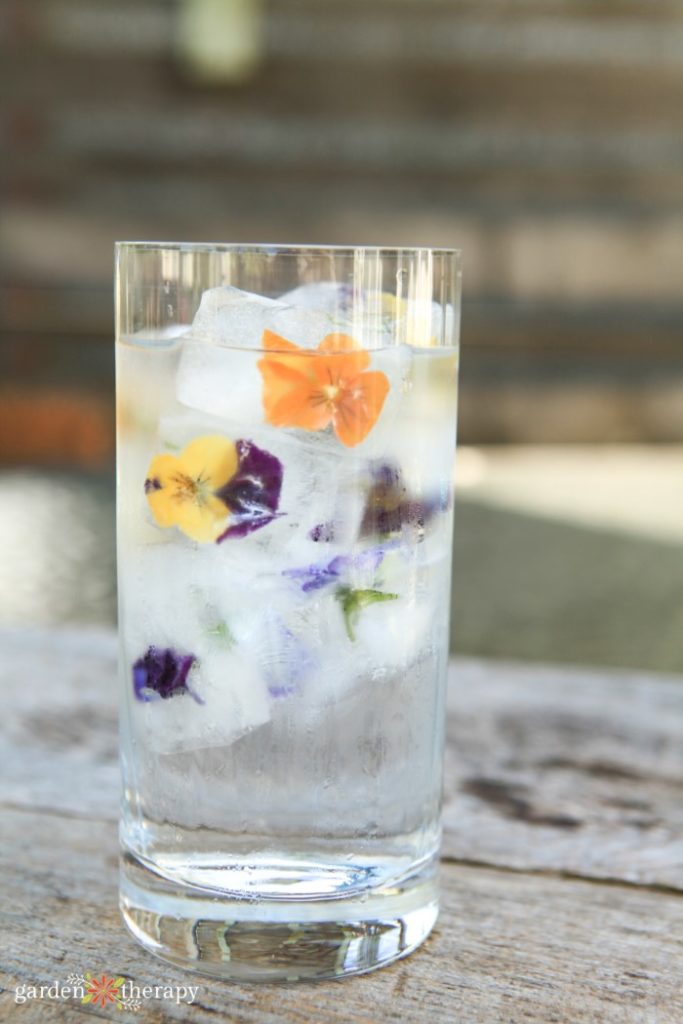
Flowerfetti Salad
A colourful and eco-friendly alternative to confetti, flowerfetti consists of flower petals. Use edible flowers, including the petals of pansies, violets, and violas to garnish a salad. You can also use them as cake toppers, plate garnishes, and even on pizza.
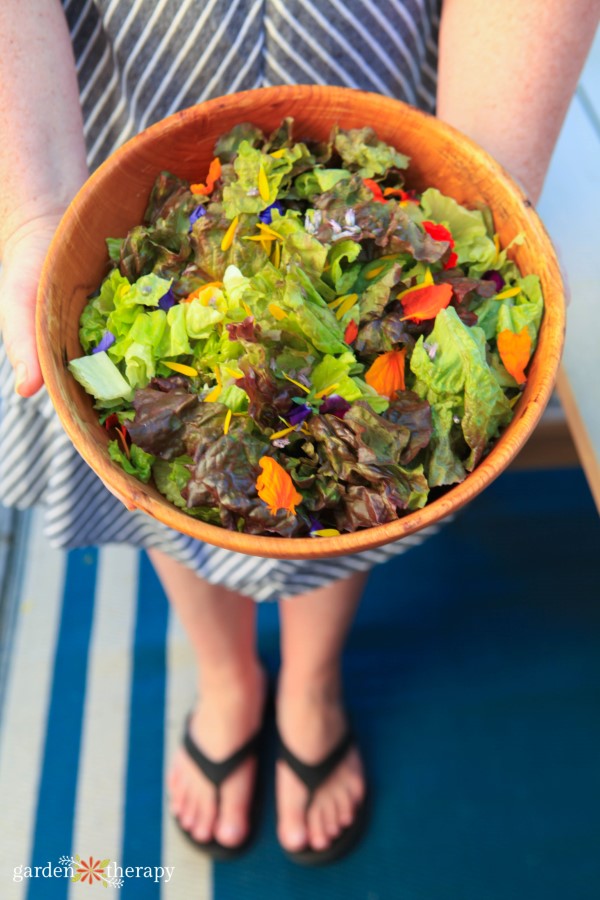
Frequently Asked Questions About Violas, Pansies, and Violets
Pansies belong to the violet family, Violaceae. Pansies typically refer to the large-bloomed flowers you would get at the garden centre. While violets can mean the whole family of Violaceae, violets often refer to a much smaller flower native to the area used in woodland gardens.
Violas are part of the violet family, Violaceae. The genus Viola consists of more than 600 plants in the violet family. Most violas, pansies, and perennial violets belong to the genus Viola.
Violets most commonly refer to the native plants found throughout Europe, North America, Asia, and Australia. Two of the most popular types of violets include the sweet violet (Viola odorata) and the common blue violet (Viola sororia).
Also in the violet family are pansies with larger blooms that can be found throughout garden centres and violas, which come in clusters of smaller flowers for the garden.
The botanical name for plants in the Violaceae family is Viola.
Pansies and violas can last you from late winter all the way to late fall. They’re very hardy and resilient plants and don’t mind the cold one bit. They can die back in the summer if they receive too much sun. While treated as annuals, they’re considered short-lived perennials and can return after the winter when it begins to warm.
Baby pansies are often called miniature pansies or violas. They look like mini versions of the garden pansy, oftentimes with plenty of blooms per plant.

I hope you learned something new about the viola family! I can’t get enough of these edible beauties and sure hope you give them a try this spring.

